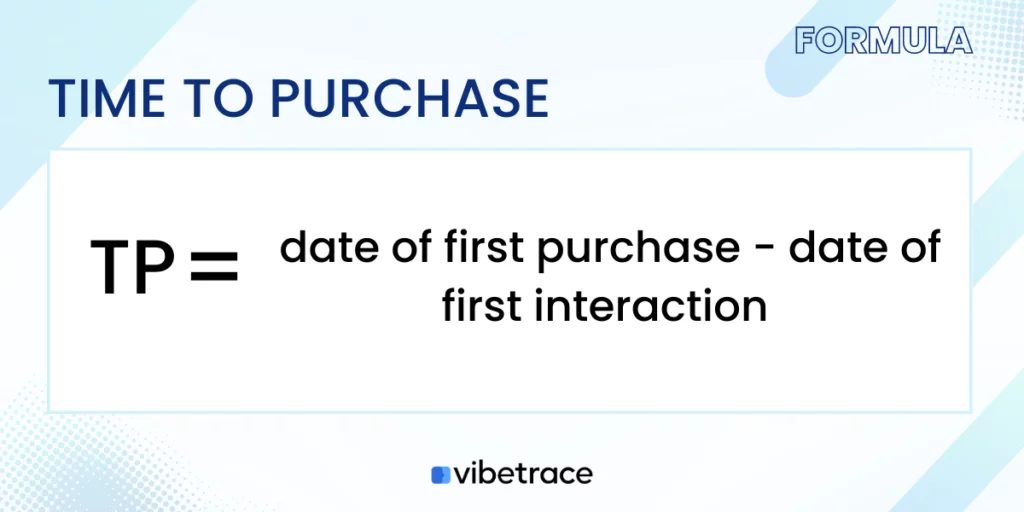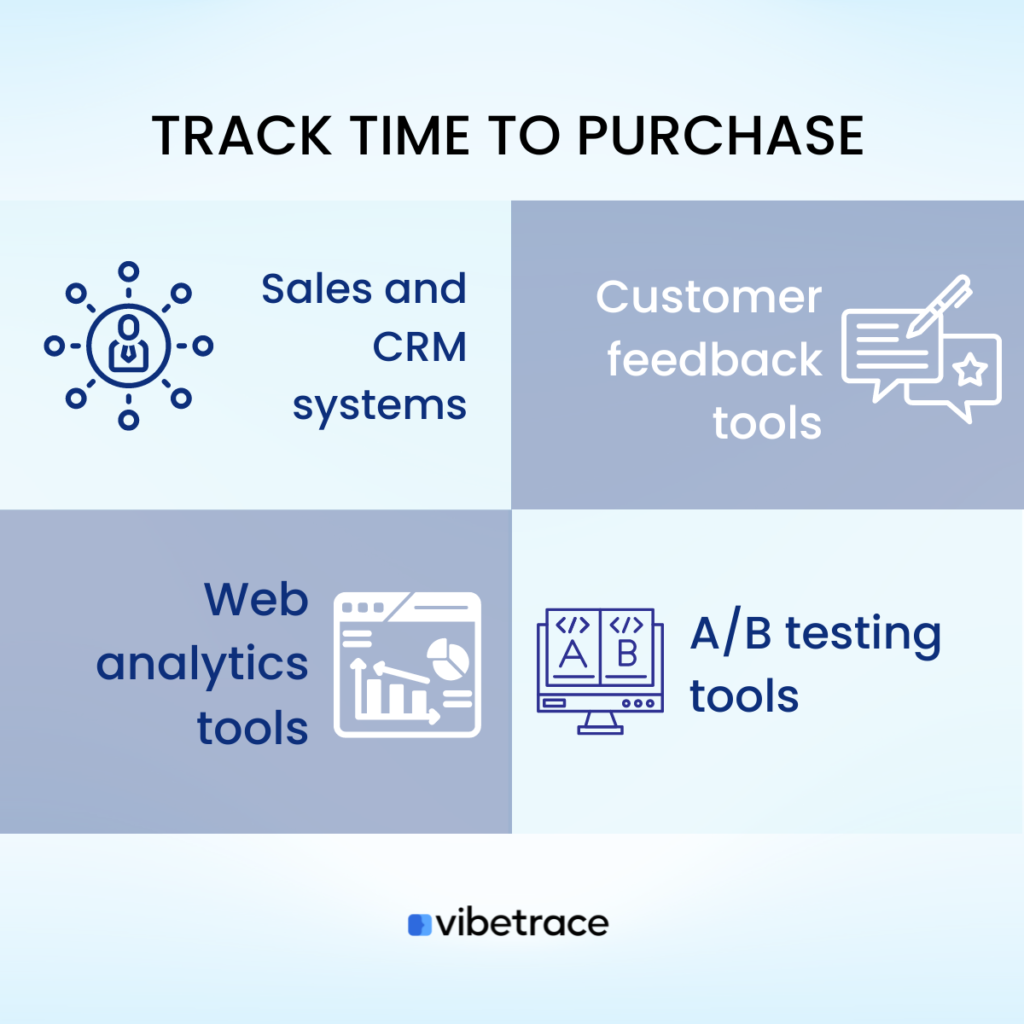Time to Purchase is a metric that indicates the time when your visitors convert into customers by making a purchase from your business.
The way people react to your offers may vary. Some might get easily caught up with your promotions and make their first purchase immediately, while others may take some time to think before doing so.
In this case, you can use this metric as a reference to understand how your advertisements and other marketing efforts are paying off.
What is Time to Purchase?
Definition of Time to Purchase
Time to Purchase is a metric that measures the amount of time that elapses between a customer’s first interaction with your business and their first purchase.
It is often used in digital marketing to track the effectiveness of advertising campaigns and other marketing efforts in driving conversions.
This metric is useful for understanding how long it takes for a customer to make a purchase after clicking on an ad for your business.
By tracking this metric across different advertising channels and campaigns, you can figure out which ones are most effective at driving conversions and focus your marketing efforts accordingly.
But that’s not all. Time to Purchase can also help you identify areas for improvement in your sales process.
For example, if you notice that customers are taking a long time to make their first purchase, it may indicate that your website or checkout process needs work. Addressing these issues can make your customer experience better and increase the likelihood of conversions.
To sum it up, Time to Purchase is a handy metric for optimizing your marketing and sales efforts to drive growth!
Time to Purchase Formula
The Time to Purchase formula is relatively simple:

To calculate Time to Purchase, you just need to have data on the date of a customer’s first purchase and the date of their first interaction with your business, like the date they first visited your website or clicked on an ad.
Once you have this data, you can subtract the date of the first interaction from the date of the first purchase to calculate the Time to Purchase.
Take note that Time to Purchase can vary widely depending on your business and your customers’ buying behavior.
Some customers might make a purchase right away, while others might wait weeks or even months before converting.
That’s why it’s important to track this metric over time and compare it to industry benchmarks to get a better idea of what it means for your business.
Time to Purchase Benchmark by Industry
Here are some general benchmarks for Time to Purchase by industry:
E-commerce: In the e-commerce industry, the average Time to Purchase is around 2-3 days, with some industries such as fashion having a slightly shorter Time to Purchase, and others such as electronics having a longer Time to Purchase.
Travel: In the travel industry, the average Time to Purchase is typically longer, with customers taking around 30-45 days to make a purchase decision.
Finance: In the finance industry, the Time to Purchase can vary widely depending on the product or service being sold. For example, customers may take several months to make a decision about a mortgage, while credit card purchases may have a much shorter Time to Purchase.
B2B Sales: In B2B sales, the Time to Purchase can be even longer, with some businesses taking several months or even years to make a purchase decision.
Do you like this article?
Join our CX for Retail dedicated newsletter!

Stay connected to what’s really important to optimize your digital revenues.
By clicking the button, you accept our Terms & Conditions. Also you will need to confirm your email address.
How to track Time to Purchase?
It’s important to track Time to Purchase regularly and make adjustments to your marketing and advertising efforts based on the results.
Here are some general tools you can use to track Time to Purchase:

Sales and CRM systems: Many sales and CRM systems, such as Salesforce, HubSpot, and Zoho CRM, offer features that allow you to track the time it takes for a lead to become a customer. These systems can help you understand the entire customer journey, from the initial contact to the final purchase.
Customer feedback tools: Feedback tools, such as UserTesting and Qualaroo, can provide insights into how customers interact with your website or app, and how long it takes for them to make a purchase. These tools can help you identify pain points in the customer journey and improve the overall user experience.
Web analytics tools: Web analytics tools, such as Google Analytics, Adobe Analytics, and Piwik, can track user behavior on your website or app, including the time it takes for users to make a purchase. These tools can provide insights into the effectiveness of your marketing campaigns and help you optimize your website or app for conversions.
A/B testing tools: A/B testing tools, such as Optimizely and VWO, can help you test different variations of your website or app to see which version leads to more conversions and a shorter time to purchase.
These are just a few examples of general tools you can use to track Time to Purchase. It’s essential to choose a tool that fits your specific business needs and budget.
How often should you check Time to Purchase?
The frequency at which you should check Time to Purchase depends on the nature of your business and the level of analysis required.
In general, it’s a good idea to check Time to Purchase on a regular basis to ensure that you are meeting your business goals and that your marketing campaigns are effective.
Monthly or Quarterly: If you run a business that has a longer sales cycle, such as B2B sales, you may want to check Time to Purchase on a monthly or quarterly basis to ensure that you are meeting your sales targets and that your marketing campaigns are effectively moving leads through the sales funnel.
Time to Purchase Calculator
Do you want to calculate the time to purchase? Use our simple calculator below.
Simple Time to Purchase Calculator
This is not easy to calculate using a calculator.
You need to compute the difference for new customers between date of first website interaction and time of first purchase.
You will have a table like this below:
| Customer | Days Difference |
| A | 9 |
| B | 2 |
| C | 7 |
| D | 1 |
| E | 5 |
| Avg. | 4.8 days. |
Important Things about Time to Purchase
Here are some important things to know about Time to Purchase:
Describes customer’s interest and behavior: Time to Purchase is a key metric for your business if you want to understand your customer’s behavior and measure the effectiveness of your marketing campaigns.
Varies by Industry: Time to Purchase can vary depending on the industry, the product or service being sold, and the customer demographics. It’s important to establish benchmarks for your business and track changes in Time to Purchase over time.
Time to Purchase is influenced by many factors: The customer journey, the user experience, the quality of your product or service, and the effectiveness of your marketing and advertising affects the result of the Time to Purchase.
Positive result of Shortened Time to purchase: Shortening Time to Purchase can lead to increased customer satisfaction, higher conversion rates, and improved revenue. You can use different strategies to shorten Time to Purchase, such as simplifying the checkout process, improving the user experience, offering promotions or discounts, and providing excellent customer service.
Metrics related to Time to Purchase
Here are some metrics related to Time to Purchase:
Average Order Value
Repeat Purchase Rate
The percentage of customers who make more than one purchase from your website.
Time on Site
The amount of time visitors spends on your website.
Vibetrace is a marketing automation platform that can help your business improve its customer engagement and increase sales. One way Vibetrace can help you with your Time to Purchase is by providing targeted and personalized messaging to customers based on their behavior and interests.
Additionally, Vibetrace can track a customer’s behavior on a website, such as pages viewed and products searched for, and use this information to create personalized messages that are more likely to convert them into a sale.
By using these tactics, Vibetrace can help you increase customer engagement, build loyalty, and ultimately, improve your Time to Purchase.

